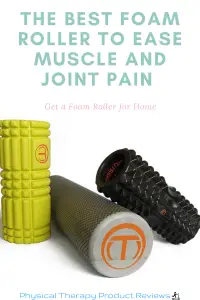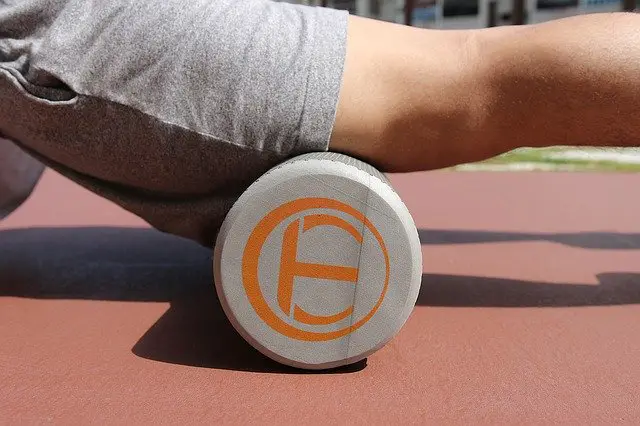 Injuries to the knee joint are fairly common. According to one study published by the Society for Academic Emergency Medicine, there were an estimated 6.6 million knee injuries that presented to U.S. emergency departments from 1999 through 2008 – which averaged out to around 2.29 knee injuries per 1,000 population (1). Injuries of the knee joint can also take a long time to heal; therefore, knowing how to properly manage your own recovery is important. One of the best tools to utilize for rehabilitation is a foam roller. A foam roller is a great alternative due to their low cost, ease of use, and ability to perform by yourself.
Injuries to the knee joint are fairly common. According to one study published by the Society for Academic Emergency Medicine, there were an estimated 6.6 million knee injuries that presented to U.S. emergency departments from 1999 through 2008 – which averaged out to around 2.29 knee injuries per 1,000 population (1). Injuries of the knee joint can also take a long time to heal; therefore, knowing how to properly manage your own recovery is important. One of the best tools to utilize for rehabilitation is a foam roller. A foam roller is a great alternative due to their low cost, ease of use, and ability to perform by yourself.
How Does a Foam Roller Work?
As the name implies, a foam roller is a cylinder-shaped object made of firm foam. In recent years it has become a widely used piece of equipment for pre and post-workout recovery. It has also been found to be a helpful tool for aiding recovery from various injuries. Some experts believe that foam rollers exert their effect by activating the central nervous system (CNS) – the part of the body that recognizes and reacts to pain. Ramping up the CNS also helps to improve blood flow. Additionally, recent research suggests that foam rolling may decrease the “viscosity” of a muscle, thereby improving its flexibility and range of motion.
Don’t have a foam roller but need one? Check out our review of the best foam rollers to help with pain and increase mobility 
What are the Benefits of Foam Rolling?
Foam Rolling, although a simple practice, has a number of benefits. It is often used by athletes to prevent injury as well as by individuals recovering from various injuries. Here are just a few of the many benefits of foam rolling:
- Increased blood flow
- Increased muscle flexibility and range of motion
- Lower risk of injury
- Quicker recovery from injuries
- Decreased post-workout pain and muscle fatigue
How to Foam Roll Correctly
In order to properly use a foam roller, first situate yourself on a flat surface, preferably on top of a foam or rubber mat. Then place the roller on the mat and lay the muscle you want to target on top of the roller. Next, gently roll the muscle over the roller back and forth, and try to target the areas of tightness within the muscle. Make these areas your primary points to focus on during the session. Aim for just 30 to 60 seconds and repeat for a total of three sets. As you become more comfortable with foam rolling you should gradually try to increase your sessions to between 10 and 20 minutes.
Common Knee Injuries that Would Benefit From Foam Rolling
Using a foam roller can help improve the recovery process for a number of knee injuries and problems, some of which are:
- Anterior cruciate ligament (ACL) tears
- Collateral ligament tears
- Meniscal tears
- Dislocation
- Tendon tears
- Recovery from knee surgery
The Best Foam Roller Exercises for Knee Problems
Foam Roll the Quad Muscles
Start out in a plank position, lying prone with your elbows and forearms on the floor, and with a foam roller positioned under your upper thigh muscles. Gently roll across the foam roller from your pelvis to just above your knee – being careful to avoid rolling over your kneecaps. In order to maintain proper form during the exercise, be sure to keep your core engaged throughout the movements. Try to roll for 30 to 60 seconds and then repeat these steps two more times for a total of three sets per session.
Foam Roll the Hamstring Muscles
To begin this exercise, come to a sitting position with your arms stretched behind you. Stretch one leg out in front of you with a foam roller under the hamstring while having the opposite knee bent. Keep your buttocks just off the floor and roll your hamstring over the roller gently forward and backward from below the buttocks to just above the knee. Switch the legs and repeat the process, striving for 30 to 60 seconds per leg.
Foam Roll the Adductor Muscles
Position yourself on a mat facing down on your hands and knees, with your hands being shoulder-width apart. Line up a foam roller next to you on the mat with the foam roller positioned parallel to your body. Next, place the inside of your upper right leg over the roller and roll from above the knee to the middle of the adductor muscle. Repeat this process for a total of 10 times. Next, position the roller in the middle of the adductor and roll it back and forth to the groin area 10 times. This will ensure that you have targeted the full adductor muscle. Repeat these steps for the left leg.
Foam Roll the Calf Muscles
Begin in a seated position with your arms stretched behind you and palms on the floor. Bend one knee and stretch out the opposite leg with the calf positioned over a foam roller. Lift your body up with your arms, keeping your buttocks just off the floor. Move your calf forward and backward over the roller and point your toes up and out to in order to fully release the muscle. For a deeper muscle release, cross your other leg over and continue to move back and forth over the roller. Again, try to roll for 30 to 60 seconds with each leg.
Foam Roll the Glute Muscles and Outside of the Hips
Place the roller under your right glute muscle and stretch out your right arm behind you. Then bend your left knee and put your right ankle above the left knee. Next, lean towards your right side to add pressure to your right glute. Then roll your right glute muscle over the roller forward and backward, supporting yourself with your right hand and left foot. Roll for about 30 to 60 seconds and repeat these steps for the opposite side to target the left glute muscle.
Bridges on a Foam Roller
Lay on your back on a flat surface with your knees bent and place your feet on top of a foam roller. Next, raise your pelvis up and focus on driving the heels of your feet down while simultaneously focusing on engaging the hamstrings. This process is what’s known as “bridging” and you should perform this process multiple times in order to give the hamstrings a proper stretch.
Conclusion
Knee injuries occur very frequently and recovery from them can be a long and difficult process. However, by stretching and engaging the muscles and tissue around the knee joint, the recovery can be greatly improved and even shortened. One of the best ways to target and engage the key muscle groups around the knee is with a foam roller. By following the tips and techniques above you will be greater equipped to self manage your recovery.
Works Cited
Gage BE, McIlvain NM, Collins CL, Fields SK, Comstock RD. Epidemiology of 6.6 million knee injuries presenting to United States emergency departments from 1999 through 2008. Acad Emerg Med. 2012;19(4):378‐385. doi:10.1111/j.1553-2712.2012.01315.x
The Effects of Myofascial Release With Foam Rolling on Performance
Foam Rolling for Delayed-Onset Muscle Soreness and Recovery of Dynamic Performance Measures
Effects of Foam Rolling and Statis Stretching on Passive Hip Flexion Range of Motion
Foam Rolling as a Recovery Tool after an Intense Bout of Physical Activity
An Acute Bout of Self-Myofascial Release in the Form of Foam Rolling Improves Performance Testing
The Effect of Foam Rolling Duration on Hamstring Range of Motion
Disclaimer: The information provided in this post is for educational purposes only. This is not a substitute for a medical appointment. Please refer to your physician before starting any exercise program.


